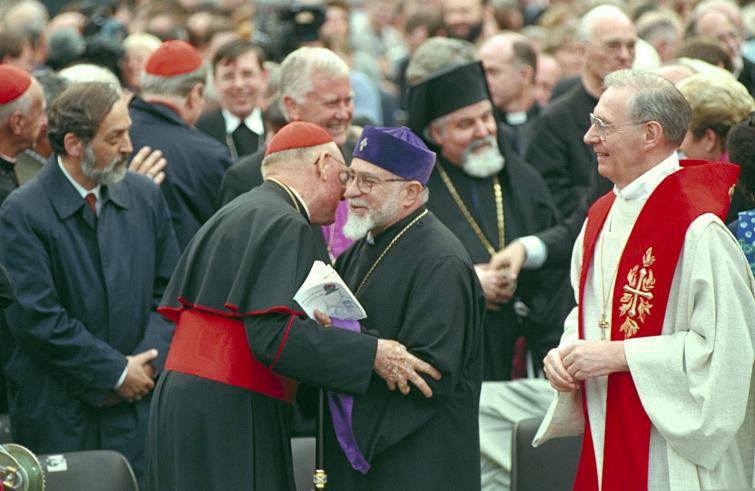Ecumenism
The heritage of the second European Ecumenical Assembly. Christian reconciliation involves men and women at all levels, encompassing existential, social, political, environmental and economic issues. The progress of the two European ecclesial bodies – Ccee and Cec – has continued after Sibiu, in particular with the joint Ccee-Cec Committee and the Catholic Orthodox Forum. Efforts are being made and steps forward are being taken, the wind of Graz is still blowing and for this very reason, the “dream of a Fourth European Ecumenical Assembly” must not be shelved

“In Graz, we have become even more aware that the Churches cannot seriously and credibly address Europe and the world nor can they support the yearning for happiness, meaning, celebration, for the eternal that is in the heart of everyone unless they focus first of all on the quest for reconciliation between them.”
These words, drawn from the final document of the II European Ecumenical Assembly, held in Graz June 23-29 1997 on the theme “Reconciliation A Gift of God and a Source of New life”, were delivered by Aldo Giordano and Jean Fischer. The former, current apostolic nuncio in Venezuela, was the then Secretary General of the Council of European Bishops’ Conferences/Ccee, while the latter served as Secretary General of the Conference of European Churches. (Cec).

Within a framework of hope
The meeting in Graz was preceded by the First Ecumenical Assembly in Basel, held May 15-21 1989 on the theme “Peace in Justice”, followed by the Third European Ecumenical assembly held in Sibiu (Romania) September 4 to 9 2007, on the theme “The light of Christ shines upon all: Hope for renewal and Unity in Europe.” Along the same lines figure two documents of great import for the ecumenical journey in Europe: the “Charta Oecumenica – Guidelines for the Growing Cooperation among the Churches in Europe (April 22 2001) and the post-Synodal Apostolic Exhortation “Ecclesia in Europa” by John Paul II (June 28 2003).
The assembly in Graz was attended by 700 delegates from 124 Protestant, Anglican, Orthodox Churches and Old Catholic Churches affiliated to CEC as well as by representatives of all 34 European Bishops’ Conferences. 150 representatives of ecclesial, ecumenical movements and organizations, some 20 guests representing other world continents and religions, in addition to over 10,000 Christians from all European nations equally attended the meeting, not to mention the inhabitants of the Austrian city.
A significant detail: after Basel (West) ecumenical dialogue moved to Graz (Centre) and with the fall of the Berlin Wall (November 9 1989) Sibiu began to take shape as the next venue.

An ecumenism of the people
Along with the official delegates, the “community of believers” spontaneously gathered in Graz, indicating that the newness of the assembly lied in the fact that many people, previously unknown to each other, discovered one another as brothers and sisters in their sharing of the same faith. The joint prayer, the act of listening and encounters on the Word of God reconfirmed that the ecumenical journey is not primarily a matter of debates or organization. It pertains to life. It is no longer possible to confine ecumenism to the theological sphere alone, to meetings between Church leaders or to the activities of certain outposts. Ecumenism is a journey that must be undertaken together, it should inhabit the ordinary pastoral ministry of Catholic communities. Here we find the thought of Pope Francis on the ecumenism of the people, on the ecumenism of all those who find in baptism the reasons and the strength to undertake a joint course, in some cases to the point of martyrdom, to eventually arrive to what the present Pope describes as “the ecumenism of blood.”
The Cross in the open-air cathedral
The theme of Reconciliation led some to fear an inward focus at internal level, inside the Churches. Gradually, its missionary bearing was fully acknowledged. Christian reconciliation involves the questions of men and women at all levels, ranging from existential issues to encompass social, political, environmental and economic ones. The first to acknowledge “the joint commitment” to meet the challenge of proclaiming the Gospel across European culture and societies, were two European ecclesial bodies: CCEE and CEC. During the Assembly’s final celebration ceremony, looking at the Cross erected in the park serving as an open-air cathedral, participants perceived that “the unity between Christians and ecumenism will be fulfilled on the way of the Cross”. The Paschal Christ teaches us that the mission of the Churches in Europe and in the rest of the world today is to ‘wash each other’s feet’ and to serve the poor, the excluded and the stranger in particular.”
A journey and a “dream”
After Graz was celebrated Sibiu’s 2007 Assembly. No fourth assembly has ensued. Have CCEE and CEC stopped along the path of ecumenism? The book “L’incontro e la speranza” (Cantagalli ed.s 2016) that documents 10 years of CCEE activity – from 2006 to 2016 – shows that the journey of the two European ecclesial bodies continued also after Sibiu, in particular with the joint CCEE-CEC Committee and the Catholic-Orthodox Forum. Progress has been made and steps forward are being taken, the wind of Graz continues to blow, and once more, for this very reason, the “dream” of a Fourth European Ecumenical Assembly must not be shelved.